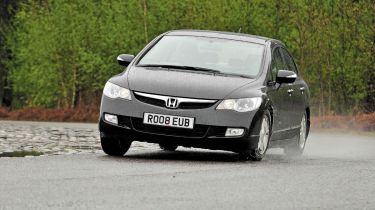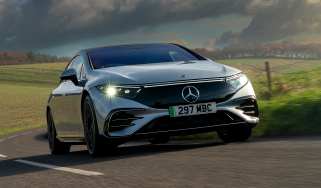Honda Civic Hybrid ES
Gutless electric motor hampers the saloon
Are hybrid cars the future? While there’s no doubt they have helped drive down CO2 emissions, questions remain over the true benefits to fuel economy, especially out of town. As the Prius shows, the concept can work – but does the Honda Civic Hybrid IMA pull off a similar trick?
IMA stands for Integrated Motor Assist. As with its Toyota rival, the Honda uses an electric motor to boost the power of its petrol engine – the 1.4 is upped to 94bhp. The idea is to offer the pace of a 1.6-litre with the economy and emissions of a 1.1.
The electric motor is triggered by the brake pedal. Slow down or come to a standstill, and the petrol unit is disengaged; accelerate again, and it fires up. The problem is, the electric motor gives only 15kW, compared to 50kW in the Prius and 147kW in the Lexus. As a result, it’s not strong enough to propel the oddball four-door Civic on its own, so the engine is employed more than you’d expect.
Also letting the car down is the CVT box. While its shift-free running means smooth progress, the set-up holds the engine noisily at high revs when accelerating. This explains why the IMA failed to match the firm’s economy claims in our test, too.
Jerky and over-sensitive brakes make it hardto drive the Honda smoothly. The ride is poor in town, while thick A-pillars cause large blind spots – key flaws in a car designed for urban use.
The good news is that even greener Hondas are on the way. The FCX Clarity is the first commercially available hydrogen fuel cell vehicle in the world. It hits 100mph, covers 0-60mph in 10 seconds and doesn’t use a drop of fuel. And while it’s currently only available in California, it’s sure to come here – and prove a stronger package than the Civic Hybrid.
Details
Price: £18,005
Model tested: Civic Hybrid ES



